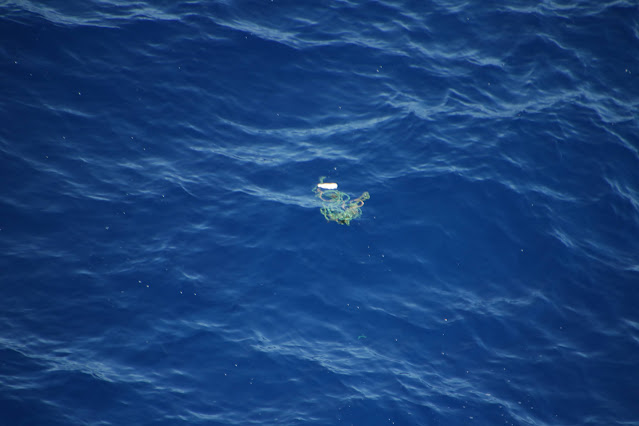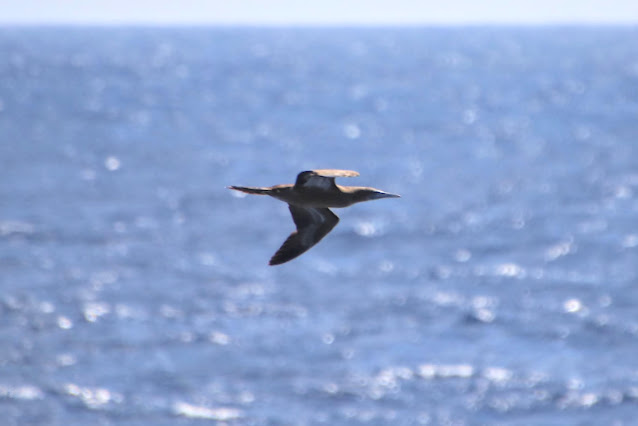A cruise from Seattle to Honolulu sounded like a great idea. I liked the line, Princess; the ship, the Royal, had the best running track at sea; and the price was cheap. Plus with five days at sea, I was bound to encounter some pelagic birds like albatrosses and shearwaters. But rain showers while boarding should have reminded me that good weather wasn't a guarantee.
In Puget Sound shortly after our sail away, I witnessed a tight flock of birds flying close to the water's surface. Unfortunately they were so distant it was hard to identify them as surf scoters or harlequin ducks or any specific coastal bird. The only seabird I could clearly make out in the area was a type of gull, most likely a glaucous-winged.
I wasn't prepared for the next day at sea when high swells and constant, unpredictable motion caused me seasickness. It was difficult to focus on the shipboard naturalist's lectures, let alone indulge in the 24-hour dining options. For safety, the outside decks were mostly closed. While the fresh air might have helped my queasiness, I really wasn't in any shape to scan the area for seabirds anyway.
The conditions weren't much better the following day but candied ginger, abstinence from alcohol, and acclimating to the pitch and roll of the ship all very much improved my condition. I was finally ready to explore the outside decks but was disheartened to discover them all still closed because of high winds. At least steadily improving weather was in the forecast.
It was shortly before this time in the sailing that a stowaway was discovered on the ship. While I never saw the Leach's storm petrel in person, a few passengers photographed the bird while it rested on their staterooms' balconies. Only a short way out to sea and we were already encountering pelagic birds!
I was even more excited on our third day at sea when I awoke to calm conditions and balmy temperatures. Finally, weather I could associate with Hawaii! The crew opening the top deck's running track shortly after sunrise was like Macy's opening its doors on Black Friday as the fitness buffs rushed upstairs to the Sports Deck.
Thrilled to be outside, I scanned the surf near the ship and the sea and skies beyond. But I didn't see a single bird, only flying fish darting away from the ship's wake. I also noticed debris in the water, much of it flotsam from other boats. Barrels, jugs, nets, basins, floats, pieces of plastic and aluminum, much of it barnacle-encrusted, floated close by the cruise ship. By the end of day, I could have easily counted three items every minute.
Every cruise I've ever taken was mostly over a continental shelf, where I've noticed very little garbage. However for the first time I was in the middle of the North Pacific, half way to Hawaii, and I was seeing human detritus. Closer to the continent, was the debris being washed ashore out of seafarers' sights? Far at sea, did it just drift, eventually joining the Great Pacific garbage patch?
Indeed I'm afraid the ship might have been skirting the eastern section of the Pacific trash vortex, as it's also called. In the patch itself are an uncountable number of microplastics that make the ocean look like a cloudy soup. The pieces I was witnessing were probably following the currents formed by warm water from the South Pacific meeting up with cooler water from the Arctic, perhaps eventually breaking down and joining the patch.
Water, water everywhere, and not a drop unmarred by mankind's touch. While the closed decks were disappointing, the appearance of garbage was devastating. I could only imagine the additional debris below the ship, on the ocean bottom, and beyond the narrow path we were cutting. I couldn't fathom the entire patch itself which is larger than the state of Texas.
Meanwhile the skies belied the pollution on and below the sea. Tall, tropical thunderclouds released distant rain showers that birthed panoramic rainbows. The high mid-day sun warmed the many Canadian passengers avoiding winter for a just a little while longer. Sublime sunrises greeted me and my cup of coffee every morning and equally beauteous sunsets signaled the start of the evening's shipboard festivities.
The morning of the fourth day I actually saw a bird while I ran outside up on the Sports Deck. With no camera in hand, I only have the memory of its gray torso and its gull-like size while it flew close by. But it wasn't a gull as those species live outside of the tropics, close to a continent's shores. The next day - the last at sea - I captured a grainy image of another bird which might possibly have been the same species. Stout and gray, its identification eluded me.
It was much easier to identify the next bird I photographed, a type of booby. It looked like a juvenile brown variety but Hawaii seemed to be outside its normal range.
Finally, after five days at sea, the Royal Princess sailed into Honolulu harbor. I disembarked and flew back to the States the following evening around the same time my ship was leaving Kona on the Big Island. By the time I landed in Phoenix the Royal was headed to Tahiti.
The day after I arrived home, a friend still on board sent me a picture of another stowaway, a wedge-tailed shearwater resting on an outside deck. The species breeds in the Hawaiian islands from March through November. Soon thereafter, I received a video of what appeared to be a soaring albatross along with more pictures of clouds, sunsets, and sunrises as the ship crossed the equator. There was mercifully no more word of a garbage patch.





Comments
Post a Comment